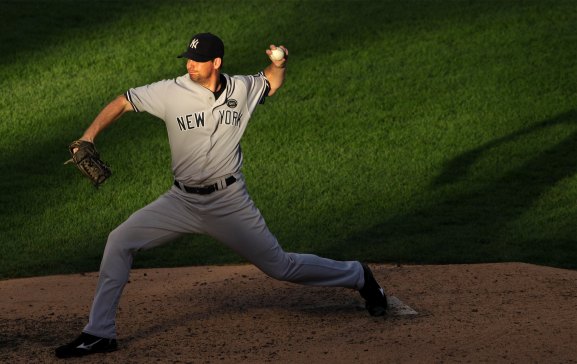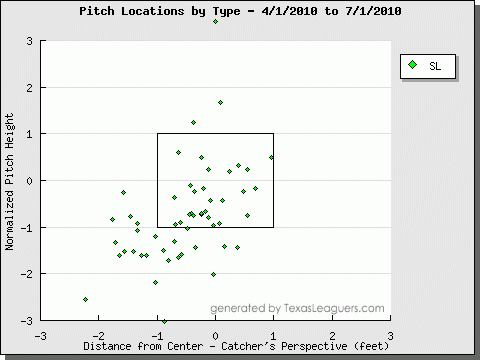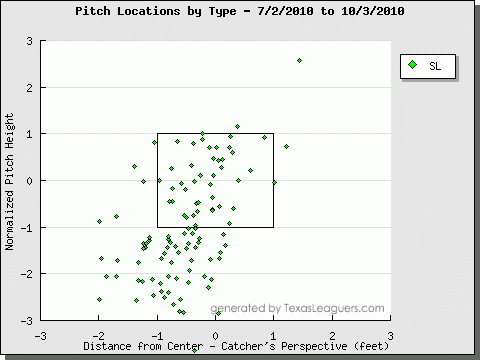
Real quick: take a look at Boone Logan’s 2010 numbers. They look pretty spiffy, no? You can’t ask much more from a young lefty reliever. What made Logan look even better was the value he provided. Although he faced just 169 batters in 40 innings, he still produced 0.4 WAR, which was 0.6 more than the other player the Yankees acquired from the Braves last winter. Since Logan provided more value this year and will continue to provide more in the future, we can accurately term this the Boone Logan Trade. But it wasn’t always that way.
Because the Yankees started the season stocked with bullpen arms, Logan started the year in AAA Scranton. He made his way to the big league club early on, and made his first appearance on April 20. Things didn’t go so well during that first stint. Logan faced 49 batters in 10.2 innings and walked seven batters while striking out six. It led to six earned runs, a 5.06 ERA. The Yankees optioned him, but then recalled him again in mid-June, though that didn’t exactly go well either. This time Logan faced 33 batters in 7.2 innings, striking out seven and walking five. The results were better, but he clearly still had control issues.
Logan’s 3.93 first half ERA didn’t look so bad, but his walk issues made it hard to trust him against tough left-handed hitters. He finished the half with 12 walks in 18.1 innings, leading to an opponent OBP of .390. He threw 314 pitches to 82 batters, almost four per. Clearly something would have to change if he was going to stick in the second half. By the time the Yankees recalled him for the third time in the season, something had.
The second half didn’t open ideally for Logan, as he allowed a run in 1.2 innings against the Rays. The good news is that he didn’t walk a batter, and he threw 15 of 23 pitches for strikes (65%). He continued to throw strikes in subsequent appearances, and it paid off. He walked just eight in 21.2 second-half innings, a marked improvement over his first half numbers. It led to a mere .264 opponents’ OBP. Hitters also had trouble making solid contact, as his BABIP went down to .235. This was due, in large part, to a mere 8 percent line drive rate, down from 25 percent in the first half.
How did Logan accomplish this mid-season transformation? Part of it was certainly throwing more strikes. In the first half he threw 60 percent of his pitches for strikes, while in the second half that was up to 63 percent. That might not seem like a huge increase, but it can make a big difference when you’re often working one batter at a time. But it doesn’t account for the entire difference. The biggest change, as most of us can probably intuit, was pitch selection and effectiveness.
In the first half Logan was extremely fastball heavy, throwing it 70.9 percent of the time. He got a meager 8.9 percent whiff rate on it, leading to a 21.5 percent in play rate. In the second half he started leaning on his slider a lot more, using it 32.4 percent of his time. Opponents put it in play just 10.2 percent of the time, while whiffing 27.8 percent of the time. The pitch ended up being his best per FanGraphs’ Pitch Type Values, 3.8 runs above average overall, and 2.34 per 100 pitches. All it took was him using it more and commanding it better.*
*Looking at the PitchFX numbers, Logan got -0.07 inches of vertical break and -1.13 inches of horizontal break on the slider in the first half. In other words, it darted downward and towards a right-handed batter. In the second half it was 2.02 inches of vertical break and -0.29 inches horizontal. That might seem like less movement, but I have a pet theory on this. It basically goes that Logan was letting the slider fly more in the first half and was a bit more careful with it in the second half. He might have had more movement in the first half, but he was wild with it. In the second half the lower break figures point to a greater command over the pitch. Again, this is just a pet theory, but I’d love to hear some point-counterpoint on this if anyone is interested.
Just so you can see the difference, here are Logan’s slider plots from the first and second halves.
First half

Second half

Everything was away in the second half, and he buried plenty in the dirt. It’s tough to pick out the subtleties, because he threw far more in the second half than in the first. But I do think it’s clear that he kept the slider below the zone in the second half, while he was low and away in the first half. This probably led to the pitch being a lot more effective.
Given his second half performance, it’s hard to not like Logan as the primary lefty in 2011. He showed great improvements, from his peripheral numbers — 10.38 K/9, 3.32 BB/9, 0.8 HR/9 in the second half — to his pitch selection and command. Whether he can maintain these improvements remains to be seen, but he’ll get every chance to do so. With Damaso Marte out for most of, if not all of, the 2011 season, Logan becomes the primary lefty in the pen. Six months ago that would have left me feeling queasy. Amazing what a little improvement can do.
Leave a Reply
You must be logged in to post a comment.